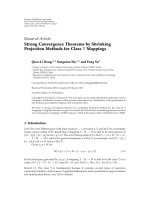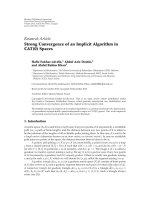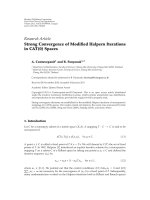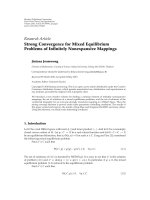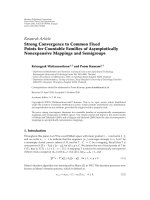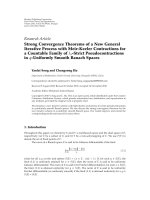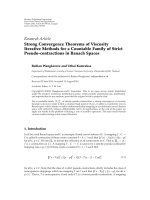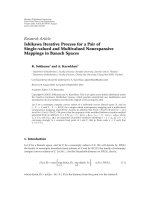Báo cáo hóa học: " Research Article Strong Convergence Theorem for a New General System of Variational Inequalities in Banach Spaces" pdf
Bạn đang xem bản rút gọn của tài liệu. Xem và tải ngay bản đầy đủ của tài liệu tại đây (517.56 KB, 13 trang )
Hindawi Publishing Corporation
Fixed Point Theory and Applications
Volume 2010, Article ID 246808, 13 pages
doi:10.1155/2010/246808
Research Article
Strong Convergence Theorem for a New General
System of Variational Inequalities in Banach Spaces
S. Imnang
1, 2
and S. Suantai
2, 3
1
Department of Mathematics, Faculty of Science, Thaksin University, Phatthalung Campus,
Phatthalung 93110, Thailand
2
Centre of Excellence in Mathematics, CHE, Si Ayutthaya Road, B angkok 10400, Thailand
3
Department of Mathematics, Faculty of Science, Chiang Mai University, Chiang Mai 50200, Thailand
Correspondence should be addressed to S. Suantai,
Received 26 July 2010; Revised 7 December 2010; Accepted 30 December 2010
Academic Editor: S. Reich
Copyright q 2010 S. Imnang and S. Suantai. This is an open access article distributed under
the Creative Commons Attribution License, which permits unrestricted use, distribution, and
reproduction in any medium, provided the original work is properly cited.
We introduce a new system of general variational inequalities in Banach spaces. The equivalence
between this system of variational inequalities and fixed point problems concerning the
nonexpansive mapping is established. By using this equivalent formulation, we introduce an
iterative scheme for finding a solution of the system of variational inequalities in Banach spaces.
Our main result extends a recent result acheived by Yao, Noor, Noor, Liou, and Yaqoob.
1. Introduction
Let X be a real Banach space, and X
∗
be its dual space. Let U {x ∈ X : x 1} denote the
unit sphere of X. X is said to be uniformly convex if for each ∈ 0, 2 there exists a constant
δ>0suchthatforanyx, y ∈ U,
x − y
≥ implies
x y
2
≤ 1 − δ. 1.1
The norm on X is said to be G
ˆ
ateaux differentiable if the limit
lim
t → 0
x ty
−
x
t
1.2
2 Fixed Point Theory and Applications
exists for each x, y ∈ U and in this case X is said to have a uniformly Frechet differentiable norm
if the limit 1.2 is attained uniformly for x, y ∈ U and in this case X is said to be uniformly
smooth.Wedefineafunctionρ : 0, ∞ → 0, ∞, called the modulus of smoothness of X,as
follows:
ρ
τ
sup
1
2
x y
x − y
− 1:x, y ∈ X,
x
1,
y
τ
. 1.3
It is known that X is uniformly smooth if and only if lim
τ → 0
ρτ/τ 0. Let q be a fixed real
number with 1 <q≤ 2. Then a Banach space X is said to be q-uniformly smooth if there exists
aconstantc>0suchthatρτ ≤ cτ
q
for all τ>0. For q>1, the generalized duality mapping
J
q
: X → 2
X
∗
is defined by
J
q
x
f ∈ X
∗
:
x, f
x
q
,
f
x
q−1
, ∀x ∈ X. 1.4
In particular, if q 2, the mapping J
2
is called the normalized duality mapping and usually, we
write J
2
J.IfX is a Hilbert space, then J I. Further, we have the following properties of
the generalized duality mapping J
q
:
1 J
q
xx
q−2
J
2
x for all x ∈ X with x
/
0,
2 J
q
txt
q−1
J
q
x for all x ∈ X and t ∈ 0, ∞,
3 J
q
−x−J
q
x for all x ∈ X.
It is known that if X is smooth, then J is single-valued, which is denoted by j.Recall
that the duality mapping j is said to be weakly sequentially continuous if for each {x
n
}⊂X
with x
n
→ x weakly, we have jx
n
→ jx weakly-∗. We know that if X admits a weakly
sequentially continuous duality mapping, then X is smooth. For the details, see the work of
Gossez and Lami Dozo in 1 .
Let C be a nonempty closed convex subset of a smooth Banach space X.Recallthata
mapping A : C → X is said to be accretive if
Ax − Ay, j
x − y
≥ 0 1.5
for all x, y ∈ C. A mapping A : C → X is said to be α-strongly accretive if there exists a
constant α>0suchthat
Ax − Ay, j
x − y
≥ α
x − y
2
1.6
for all x, y ∈ C. A mapping A : C → X is said to be α-inverse strongly accretive if there exists a
constant α>0suchthat
Ax − Ay, j
x − y
≥ α
Ax − Ay
2
1.7
for all x, y ∈ C. A mapping T : C → C is said to be nonexpansive if Tx − Ty≤x − y for all
x, y ∈ C. The fixed point set of T is denoted by FT : {x ∈ C : Tx x}.
Fixed Point Theory and Applications 3
Let D be a nonempty subset of C. A mapping Q : C → D is said to be sunny if
Q
Qx t
x − Qx
Qx, 1.8
whenever Qx tx − Qx ∈ C for x ∈ C and t ≥ 0. A mapping Q : C → D is called a retraction
if Qx x for all x ∈ D.Furthermore,Q is a sunny nonexpansive retraction from C onto D if Q
is a retraction from C onto D which is also sunny and nonexpansive.
AsubsetD of C is called a sunny nonexpansive retraction of C if there exists a sunny
nonexpansive retraction from C onto D.ItiswellknownthatifX is a Hilbert space, then a
sunny nonexpansive retraction Q
C
is coincident with the metric projection from X onto C.
Conveying an idea of the classical variational inequality, denoted by VIC, A,istofind
an x
∗
∈ C such that
Ax
∗
,y− x
∗
≥ 0, ∀y ∈ C, 1.9
where X H is a Hilbert space and A is a mapping from C into H. The variational inequality
has been widely studied in the literature; see, for example, the work of Chang et al. in 2,
Zhao and He 3, Plubtieng and Punpaeng 4, Yao et al. 5 and the references therein.
Let A, B : C → H be two mappings. In 2008, Ceng et al. 6 considered the following
problem of finding x
∗
,y
∗
∈ C × C such that
λAy
∗
x
∗
− y
∗
,x− x
∗
≥ 0, ∀x ∈ C,
μBx
∗
y
∗
− x
∗
,x− y
∗
≥ 0, ∀x ∈ C,
1.10
which is called a general system of variational inequalities,whereλ>0andμ>0aretwo
constants. In particular, if A B,thenproblem1.10 reduces to finding x
∗
,y
∗
∈ C × C such
that
λAy
∗
x
∗
− y
∗
,x− x
∗
≥ 0, ∀x ∈ C,
μAx
∗
y
∗
− x
∗
,x− y
∗
≥ 0, ∀x ∈ C,
1.11
which is defined by Verma 7 and is called the new system of variational inequalities.Further,
if we add up the requirement that x
∗
y
∗
,thenproblem1.11 reduces to the classical
variational inequality VIC, A.
In 2006, Aoyama et al. 8 first considered the following generalized variational
inequality problem in Banach spaces. Let A : C → X be a n accretive operator. Find a point
x
∗
∈ C such that
Ax
∗
,j
x − x
∗
≥ 0, ∀x ∈ C . 1.12
The problem 1.12 is very interesting as it is connected with the fixed point problem for
nonlinear mapping and the problem o f finding a zero point of an accretive operator in Banach
spaces, see 9–11 and the references therein.
4 Fixed Point Theory and Applications
Aoyama et al. 8 introduced the following iterative algorithm in Banach spaces:
x
0
x ∈ C,
y
n
Q
C
x
n
− λ
n
A
x
n
,
x
n1
a
n
x
n
1 − a
n
y
n
,n≥ 0,
1.13
where Q
C
is a sunny nonexpansive retraction from X onto C. Then they proved a
weak convergence theorem which is generalized simultaneously theorems of Browder and
Petryshyn 12 and Gol’shte
˘
ınandTret’yakov13. In 2008, Hao 14 obtained a strong
convergence theorem by using the following iterative algorithm:
x
0
∈ C,
y
n
b
n
x
n
1 − b
n
Q
C
I − λ
n
Ax
n
,
x
n1
a
n
u
1 − a
n
y
n
,n≥ 0,
1.14
where {a
n
}, {b
n
} are two sequences in 0, 1 and u ∈ C.
Very recently, in 2009, Yao et al. 5 introduced the following system of general
variational inequalities in Banach spaces. For given two operators A, B : C → X,they
considered the problem of finding x
∗
,y
∗
∈ C × C such that
Ay
∗
x
∗
− y
∗
,j
x − x
∗
≥ 0, ∀x ∈ C,
Bx
∗
y
∗
− x
∗
,j
x − y
∗
≥ 0, ∀x ∈ C,
1.15
which is called the system of general variational inequalities in a real Banach space.Theyproveda
strong convergence theorem by using the following iterative algorithm:
x
0
∈ C,
y
n
Q
C
x
n
− Bx
n
,
x
n1
a
n
u b
n
x
n
c
n
Q
C
y
n
− Ay
n
,n≥ 0,
1.16
where {a
n
}, {b
n
},and{c
n
} are three sequences in 0, 1 and u ∈ C.
In this paper, motivated and inspired by the idea of Yao et al. 5 and Cheng et al. 6.
First, we introduce the following system of variational inequalities in Banach spaces.
Let C be a nonempty closed convex subset of a real Banach space X.LetA
i
: C → X
for all i 1, 2, 3 be three mappings. We consider the following problem o f finding x
∗
,y
∗
,z
∗
∈
C × C × C such that
λ
1
A
1
y
∗
x
∗
− y
∗
,j
x − x
∗
≥ 0, ∀x ∈ C,
λ
2
A
2
z
∗
y
∗
− z
∗
,j
x − y
∗
≥ 0, ∀x ∈ C,
λ
3
A
3
x
∗
z
∗
− x
∗
,j
x − z
∗
≥ 0, ∀x ∈ C,
1.17
Fixed Point Theory and Applications 5
which is called a new general system of variational inequalities in Banach spaces,whereλ
i
> 0for
all i 1, 2, 3. In particular, if A
3
0, z
∗
x
∗
,andλ
i
1fori 1, 2, 3, then problem 1.17
reduces to problem 1.15.Further,ifA
3
0, z
∗
x
∗
,thenproblem1.17 reduces to the
problem 1.10 in a real Hilbert space. Second, we introduce iteration process for finding a
solution of a new general system of variational inequalities in a real Banach space. Starting
with arbitrary points v, x
1
∈ C and let {x
n
}, {y
n
},and{z
n
} be the sequences generated by
z
n
Q
C
x
n
− λ
3
A
3
x
n
,
y
n
Q
C
z
n
− λ
2
A
2
z
n
,
x
n1
a
n
v b
n
x
n
1 − a
n
− b
n
Q
C
y
n
− λ
1
A
1
y
n
,n≥ 1,
1.18
where λ
i
> 0foralli 1, 2, 3and{a
n
}, {b
n
} are two sequences in 0, 1.Usingthe
demiclosedness principle for nonexpansive mapping, we will show that the sequence {x
n
}
converges strongly to a solution of a new general system of variational inequalities in Banach
spaces under some control conditions.
2. Preliminaries
In this section, we recall the well known results and give some useful lemmas that will be
used in the next section.
Lemma 2.1 see 15. Let X be a q-uniformly smooth Banach space with 1 ≤ q ≤ 2.Then
x y
q
≤
x
q
q
y, J
q
x
2
Ky
q
2.1
for all x, y ∈ X,whereK is the q-uniformly smooth constant of X.
The following lemma concerns the sunny nonexpansive retraction.
Lemma 2.2 see 16, 17. Let C be a closed convex subset of a smooth Banach space X.LetD be a
nonempty subset of C and Q : C → D be a retraction. Then Q is sunny and nonexpansive if and only
if
u − Qu, j
y − Qu
≤ 0, 2.2
for all u ∈ C and y ∈ D.
The first result regarding the existence of sunny nonexpansive retractions on the fixed
point set of a nonexpansive mapping is due to Bruck 18.
Remark 2.3. If X is strictly convex and uniformly smooth and if T : C → C is a nonexpansive
mapping having a nonempty fixed point set FT, then there exists a sunny nonexpansive
retraction of C onto FT.
6 Fixed Point Theory and Applications
Lemma 2.4 see 19. Assume {a
n
} is a sequence of nonnegative real numbers such that
a
n1
≤
1 − γ
n
a
n
δ
n
,n≥ 1, 2.3
where {γ
n
} is a sequence in 0, 1 and {δ
n
} is a sequence such that
i
∞
n1
γ
n
∞;
ii lim sup
n →∞
δ
n
/γ
n
≤ 0 or
∞
n1
|δ
n
| < ∞.
Then lim
n →∞
a
n
0.
Lemma 2.5 see 20. Let {x
n
} and {y
n
} be bounded sequences in a Banach space X and let {b
n
} be
a sequence in 0, 1 with 0 < lim inf
n →∞
b
n
≤ lim sup
n →∞
b
n
< 1. Suppose x
n1
1−b
n
y
n
b
n
x
n
for all integers n ≥ 1 and lim sup
n →∞
y
n1
− y
n
−x
n1
− x
n
≤ 0.Then,lim
n →∞
y
n
− x
n
0.
Lemma 2.6 see 21. Let X be a uniformly convex Banach space, C a nonempty closed convex
subset of X,andT : C → C be an nonexpansive mapping. Then I − T is demiclosed at 0, that is, if
x
n
→ x weakly and x
n
− Tx
n
→ 0 strongly, then x ∈ FT.
3. Main Results
In this section, we establish the equivalence between the new general system of variational
inequalities 1.17 and some fixed point problem involving a nonexpansive mapping. Using
the demiclosedness principle for nonexpansive mapping, we prove that the iterative scheme
1.18 converges strongly to a solution of a new general system of variational inequalities
1.17 in a Banach space under some control conditions. In order to prove our main result,
the following lemmas are needed.
The next lemmas are crucial for proving the main theorem.
Lemma 3.1. Let C be a nonempty closed convex subset of a real 2-uniformly smooth Banach space X.
Let the mapping A : C → X be α-inverse strongly accretive. Then, we have
I − λAx − I − λAy
2
≤
x − y
2
2λ
λK
2
− α
Ax − Ay
2
, 3.1
where K is the 2-uniformly smooth constant of X. In particular, if α ≥ λK
2
,thenI − λA is a
nonexpansive mapping.
Proof. Indeed, for all x, y ∈ C,fromLemma 2.1,wehave
I − λAx − I − λAy
2
x − y − λAx − Ay
2
≤
x − y
2
− 2λ
Ax − Ay
,j
x − y
2K
2
λ
2
Ax − Ay
2
≤
x − y
2
− 2λα
Ax − Ay
2
2K
2
λ
2
Ax − Ay
2
x − y
2
2λ
λK
2
− α
Ax − Ay
2
.
3.2
It is clear that, if α ≥ λK
2
,thenI − λA is a nonexpansive mapping.
Fixed Point Theory and Applications 7
Lemma 3.2. Let C be a nonempty closed convex subset of a real 2-uniformly smooth Banach space
X.LetQ
C
be the sunny nonexpansive retraction from X onto C.LetA
i
: C → X be an α
i
-inverse
strongly accretive mapping for i 1, 2, 3.LetG : C → C be a mapping defined by
G
x
Q
C
Q
C
Q
C
x − λ
3
A
3
x
− λ
2
A
2
Q
C
x − λ
3
A
3
x
−λ
1
A
1
Q
C
Q
C
x − λ
3
A
3
x
− λ
2
A
2
Q
C
x − λ
3
A
3
x
, ∀x ∈ C.
3.3
If α
i
≥ λ
i
K
2
for all i 1, 2, 3,thenG : C → C is nonexpansive.
Proof. For all x, y ∈ C,wehave
G
x
− G
y
Q
C
Q
C
Q
C
I − λ
3
A
3
x − λ
2
A
2
Q
C
I − λ
3
A
3
x
−λ
1
A
1
Q
C
Q
C
I − λ
3
A
3
x − λ
2
A
2
Q
C
I − λ
3
A
3
x
− Q
C
Q
C
Q
C
I − λ
3
A
3
y − λ
2
A
2
Q
C
I − λ
3
A
3
y
− λ
1
A
1
Q
C
Q
C
I − λ
3
A
3
y − λ
2
A
2
Q
C
I − λ
3
A
3
y
≤
Q
C
Q
C
I − λ
3
A
3
x − λ
2
A
2
Q
C
I − λ
3
A
3
x
− λ
1
A
1
Q
C
Q
C
I − λ
3
A
3
x − λ
2
A
2
Q
C
I − λ
3
A
3
x
−
Q
C
Q
C
I − λ
3
A
3
y − λ
2
A
2
Q
C
I − λ
3
A
3
y
− λ
1
A
1
Q
C
Q
C
I − λ
3
A
3
y − λ
2
A
2
Q
C
I − λ
3
A
3
y
I − λ
1
A
1
Q
C
I − λ
2
A
2
Q
C
I − λ
3
A
3
x
−
I − λ
1
A
1
Q
C
I − λ
2
A
2
Q
C
I − λ
3
A
3
y
.
3.4
From Lemma 3.1,wehaveI −λ
1
A
1
Q
C
I −λ
2
A
2
Q
C
I −λ
3
A
3
is nonexpansive which implies
by 3.4 that G is nonexpansive.
Lemma 3.3. Let C be a nonempty closed convex subset of a real smooth Banach space X.LetQ
C
be
the sunny nonexpansive retraction from X onto C.LetA
i
: C → X be three nonlinear mappings. For
given x
∗
,y
∗
,z
∗
∈ C × C × C, x
∗
,y
∗
,z
∗
is a solution of problem 1.17 ifandonlyifx
∗
∈ FG,
y
∗
Q
C
z
∗
− λ
2
A
2
z
∗
and z
∗
Q
C
x
∗
− λ
3
A
3
x
∗
,whereG is the mapping defined as in Lemma 3.2.
Proof. Note that we can rewrite 1.17 as
x
∗
−
y
∗
− λ
1
A
1
y
∗
,j
t − x
∗
≥ 0, ∀t ∈ C,
y
∗
−
z
∗
− λ
2
A
2
z
∗
,j
t − y
∗
≥ 0, ∀t ∈ C,
z
∗
−
x
∗
− λ
3
A
3
x
∗
,j
t − z
∗
≥ 0, ∀t ∈ C.
3.5
8 Fixed Point Theory and Applications
From Lemma 2.2, we can deduce that 3.5 is equivalent to
x
∗
Q
C
y
∗
− λ
1
A
1
y
∗
,
y
∗
Q
C
z
∗
− λ
2
A
2
z
∗
,
z
∗
Q
C
x
∗
− λ
3
A
3
x
∗
.
3.6
It is easy to see that 3.6 is equivalent to x
∗
Gx
∗
, y
∗
Q
C
z
∗
− λ
2
A
2
z
∗
and z
∗
Q
C
x
∗
−
λ
3
A
3
x
∗
.
From now on we denote by Ω
∗
the set of all fixed points of the mapping G.Nowwe
prove the strong convergence theorem of algorithm 1.18 for solving problem 1.17.
Theorem 3.4. Let C be a nonempty closed convex subset of a uniformly convex and 2-uniformly
smooth Banach space X which admits a weakly sequentially continuous duality mapping. Let Q
C
be
the sunny nonexpansive retraction from X onto C. Let the mappings A
i
: C → X be α
i
-inverse
strongly accretive with α
i
≥ λ
i
K
2
, for all i 1, 2, 3 and Ω
∗
/
∅. For given x
1
,v ∈ C, let the sequence
{x
n
} be generated iteratively by 1.18. Suppose the sequences {a
n
} and {b
n
} are two sequences in
0, 1 such that
C1 lim
n →∞
a
n
0 and
∞
n1
a
n
∞;
C2 0 < lim inf
n →∞
b
n
≤ lim sup
n →∞
b
n
< 1.
Then {x
n
} converges strongly to Q
v where Q
is the sunny nonexpansive retraction of C onto Ω
∗
.
Proof. Let x
∗
∈ Ω
∗
and t
n
Q
C
y
n
− λ
1
A
1
y
n
, it follows from Lemma 3.3 that
x
∗
Q
C
Q
C
Q
C
x
∗
− λ
3
A
3
x
∗
− λ
2
A
2
Q
C
x
∗
− λ
3
A
3
x
∗
−λ
1
A
1
Q
C
Q
C
x
∗
− λ
3
A
3
x
∗
− λ
2
A
2
Q
C
x
∗
− λ
3
A
3
x
∗
.
3.7
Put y
∗
Q
C
z
∗
− λ
2
A
2
z
∗
and z
∗
Q
C
x
∗
− λ
3
A
3
x
∗
.Thenx
∗
Q
C
y
∗
− λ
1
A
1
y
∗
and
x
n1
a
n
v b
n
x
n
1 − a
n
− b
n
t
n
. 3.8
From Lemma 3.1,wehaveI − λ
i
A
i
i 1, 2, 3 is nonexpansive. Therefore
t
n
− x
∗
Q
C
y
n
− λ
1
A
1
y
n
− Q
C
y
∗
− λ
1
A
1
y
∗
≤
y
n
− y
∗
Q
C
z
n
− λ
2
A
2
z
n
− Q
C
z
∗
− λ
2
A
2
z
∗
≤
z
n
− z
∗
Q
C
x
n
− λ
3
A
3
x
n
− Q
C
x
∗
− λ
3
A
3
x
∗
≤
x
n
− x
∗
.
3.9
Fixed Point Theory and Applications 9
It follows that
x
n1
− x
∗
a
n
v b
n
x
n
1 − a
n
− b
n
t
n
− x
∗
≤ a
n
v − x
∗
b
n
x
n
− x
∗
1 − a
n
− b
n
t
n
− x
∗
≤ a
n
v − x
∗
b
n
x
n
− x
∗
1 − a
n
− b
n
x
n
− x
∗
a
n
v − x
∗
1 − a
n
x
n
− x
∗
.
3.10
By induction, we have
x
n1
− x
∗
≤ max
{
v − x
∗
,
x
1
− x
∗
}
. 3.11
Therefore, {x
n
} is bounded. Hence {y
n
}, {z
n
}, {t
n
}, {A
1
y
n
}, {A
2
z
n
},and{A
3
x
n
} are also
bounded. By nonexpansiveness of Q
C
and I − λ
i
A
i
i 1, 2, 3,wehave
t
n1
− t
n
Q
C
y
n1
− λ
1
A
1
y
n1
− Q
C
y
n
− λ
1
A
1
y
n
≤
y
n1
− y
n
Q
C
z
n1
− λ
2
A
2
z
n1
− Q
C
z
n
− λ
2
A
2
z
n
≤
z
n1
− z
n
Q
C
x
n1
− λ
3
A
3
x
n1
− Q
C
x
n
− λ
3
A
3
x
n
≤
x
n1
− x
n
.
3.12
Let w
n
x
n1
− b
n
x
n
/1 − b
n
, n ∈ .Thenx
n1
b
n
x
n
1 − b
n
w
n
for all n ∈ and
w
n1
− w
n
x
n2
− b
n1
x
n1
1 − b
n1
−
x
n1
− b
n
x
n
1 − b
n
a
n1
v
1 − a
n1
− b
n1
t
n1
1 − b
n1
−
a
n
v
1 − a
n
− b
n
t
n
1 − b
n
a
n1
1 − b
n1
v − t
n1
a
n
1 − b
n
t
n
− v
t
n1
− t
n
.
3.13
By 3.12 and 3.13,wehave
w
n1
− w
n
−
x
n1
− x
n
≤
a
n1
1 − b
n1
v − t
n1
a
n
1 − b
n
t
n
− v
t
n1
− t
n
−
x
n1
− x
n
≤
a
n1
1 − b
n1
v − t
n1
a
n
1 − b
n
t
n
− v
.
3.14
10 Fixed Point Theory and Applications
This together with C1 and C2,weobtainthat
lim sup
n →∞
w
n1
− w
n
−
x
n1
− x
n
≤ 0.
3.15
Hence, by Lemma 2.5,wegetx
n
− w
n
→0asn →∞.Consequently,
lim
n →∞
x
n1
− x
n
lim
n →∞
1 − b
n
w
n
− x
n
0.
3.16
Since
x
n1
− x
n
a
n
v − x
n
1 − a
n
− b
n
t
n
− x
n
, 3.17
therefore
t
n
− x
n
−→ 0asn −→ ∞ . 3.18
Furthermore, by Lemma 3.2,wehaveG : C → C is nonexpansive. Thus, we have
t
n
− G
t
n
Q
C
y
n
− λ
1
A
1
y
n
− G
t
n
Q
C
Q
C
z
n
− λ
2
A
2
z
n
− λ
1
A
1
Q
C
z
n
− λ
2
A
2
z
n
− G
t
n
Q
C
Q
C
Q
C
x
n
− λ
3
A
3
x
n
− λ
2
A
2
Q
C
x
n
− λ
3
A
3
x
n
− λ
1
A
1
Q
C
Q
C
x
n
− λ
3
A
3
x
n
− λ
2
A
2
Q
C
x
n
− λ
3
A
3
x
n
− G
t
n
G
x
n
− G
t
n
≤
x
n
− t
n
,
3.19
which implies t
n
− Gt
n
→0asn →∞.
Since
x
n
− G
x
n
≤
x
n
− t
n
t
n
− G
t
n
G
t
n
− G
x
n
≤
x
n
− t
n
t
n
− G
t
n
t
n
− x
n
,
3.20
therefore
lim
n →∞
x
n
− G
x
n
0.
3.21
Let Q
be the sunny nonexpansive retraction of C onto Ω
∗
. Now we show that
lim sup
n →∞
v − Q
v, j
x
n
− Q
v
≤ 0.
3.22
Fixed Point Theory and Applications 11
To prove 3.22,since{x
n
} is bounded, we can choose a subsequence {x
n
i
} of {x
n
} which
converges weakly to
x and
lim sup
n →∞
v − Q
v, j
x
n
− Q
v
lim
i →∞
v − Q
v, j
x
n
i
− Q
v
.
3.23
From Lemma 2.6 and 3.21,weobtain
x ∈ Ω
∗
.Now,fromLemma 2.2, 3.23, and the weakly
sequential continuity of the duality mapping j,wehave
lim sup
n →∞
v − Q
v, j
x
n
− Q
v
lim
i →∞
v − Q
v, j
x
n
i
− Q
v
v − Q
v, j
x − Q
v
≤ 0.
3.24
From 3.9,wehave
x
n1
− Q
v
2
a
n
v b
n
x
n
1 − a
n
− b
n
t
n
− Q
v, j
x
n1
− Q
v
a
n
v − Q
v, j
x
n1
− Q
v
b
n
x
n
− Q
v, j
x
n1
− Q
v
1 − a
n
− b
n
t
n
− Q
v, j
x
n1
− Q
v
≤ a
n
v − Q
v, j
x
n1
− Q
v
b
n
x
n
− Q
v
j
x
n1
− Q
v
1 − a
n
− b
n
t
n
− Q
v
j
x
n1
− Q
v
a
n
v − Q
v, j
x
n1
− Q
v
b
n
x
n
− Q
v
x
n1
− Q
v
1 − a
n
− b
n
t
n
− Q
v
x
n1
− Q
v
≤ a
n
v − Q
v, j
x
n1
− Q
v
1
2
b
n
x
n
− Q
v
2
x
n1
− Q
v
2
1
2
1 − a
n
− b
n
t
n
− Q
v
2
x
n1
− Q
v
2
≤ a
n
v − Q
v, j
x
n1
− Q
v
1
2
b
n
x
n
− Q
v
2
x
n1
− Q
v
2
1
2
1 − a
n
− b
n
x
n
− Q
v
2
x
n1
− Q
v
2
a
n
v − Q
v, j
x
n1
− Q
v
1
2
1 − a
n
x
n
− Q
v
2
x
n1
− Q
v
2
,
3.25
which implies that
x
n1
− Q
v
2
≤
1 − a
n
x
n
− Q
v
2
2a
n
v − Q
v, j
x
n1
− Q
v
.
3.26
It follows from Lemma 2.4, 3.24,and3.26 that {x
n
} converges strongly to Q
v.This
completes the proof.
12 Fixed Point Theory and Applications
Letting A
3
0andλ
i
1fori 1, 2, 3inTheorem 3.4, we obtain the following result.
Corollary 3.5 see 5,Theorem3.1. Let C be a nonempty closed convex subset of a uniformly
convex and 2-uniformly smooth Banach space X which admits a weakly sequentially continuous
duality mapping. Let Q
C
be the sunny nonexpansive retraction from X onto C. Let the mappings
A
i
: C → X be α
i
-inverse strongly accretive with α
i
≥ K
2
, for all i 1, 2 and Ω
∗
/
∅. For given
x
1
,v∈ C,andlet{x
n
}, {y
n
} be the sequences generated by
y
n
Q
C
x
n
− A
2
x
n
,
x
n1
a
n
v b
n
x
n
1 − a
n
− b
n
Q
C
y
n
− A
1
y
n
,n≥ 1,
3.27
where {a
n
}, {b
n
} are two sequences in 0, 1 such that
C1 lim
n →∞
a
n
0 and
∞
n1
a
n
∞;
C2 0 < lim inf
n →∞
b
n
≤ lim sup
n →∞
b
n
< 1.
Then {x
n
} converges strongly to Q
v where Q
is the sunny nonexpansive retraction of C onto Ω
∗
.
Acknowledgments
The authors wish to express their gratitude to the referees for careful reading of the
manuscript and helpful suggestions. The authors would like to thank the Commission
on Higher Education, the Thailand Research Fund, the Thaksin university, the Centre o f
Excellence in Mathematics, and the Graduate School of Chiang Mai University, Thailand for
their financial support.
References
1 J P. Gossez and E. Lami Dozo, “Some geometric properties related to the fixed point theory for
nonexpansive mappings,” Pacific Journal of Mathematics, vol. 40, pp. 565–573, 1972.
2 S S. Chang, H. W. J. Lee, and C. K. Chan, “A new method for solving equilibrium problem fixed point
problem and variational inequality problem with application to optimization,” Nonlinear Analysis.
Theory, Methods & Applications, vol. 70, no. 9, pp. 3307–3319, 2009.
3 J. Zhao and S. He, “A new iterative method for equilibrium problems and fixed point problems of
infinitely nonexpansive mappings and monotone mappings,” Applied Mathematics and Computation,
vol. 215, no. 2, pp. 670–680, 2009.
4 S. Plubtieng and R. Punpaeng, “A new iterative method for equilibrium problems and fixed
point problems of nonexpansive mappings and monotone mappings,” Applied Mathematics and
Computation, vol. 197, no. 2, pp. 548–558, 2008.
5 Y. Yao, M. A. Noor, K. Inayat Noor, Y C. Liou, and H. Yaqoob, “Modified extragradient methods for
a system of variational inequalities in Banach spaces,” Acta Applicandae Mathematicae, vol. 110, no. 3,
pp. 1211–1224, 2010.
6 L C. Ceng, C Y. Wang, and J C. Yao, “Strong convergence theorems by a relaxed extragradient
method for a general system of variational inequalities,” Mathematical Methods of Operations Research,
vol. 67, no. 3, pp. 375–390, 2008.
7 Ram U. Verma, “On a new system of nonlinear variational inequalities and associated iterative
algorithms,” Mathematical Sciences Research Hot-Line, vol. 3, no. 8, pp. 65–68, 1999.
8 K. Aoyama, H. Iiduka, and W. Takahashi, “Weak convergence of an iterative sequence for accretive
operators in Banach spaces,” Fixed Point Theory and A pplications, vol. 2006, Article ID 35390, 13 pages,
2006.
Fixed Point Theory and Applications 13
9 K. Goebel and S. R eich, Uniform Convexity, Hyperbolic Geometry, and Nonexpansive Mappings, vol. 83,
Marcel Dekker, New York, NY, USA, 1984.
10 S. Reich, “Extension problems for accretive sets in Banach spaces,” Journal of Functional Analysis,vol.
26, no. 4, pp. 378–395, 1977.
11 S. Reich, “Product formulas, nonlinear semigroups, and accretive operators,” Journal of Functional
Analysis, vol. 36, no. 2, pp. 147–168, 1980.
12 F. E. Browder and W. V. Petryshyn, “Construction of fixed points of nonlinear mappings in Hilbert
space,” Journal of Mathematical Analysis and Applications, vol. 20, pp. 197–228, 1967.
13 E. G. Gol’shte
˘
ın and N. V. Tret’yakov, “Modified Lagrangians in convex programming and their
generalizations,” Mathematical Pr ogramming Study, no. 10, pp. 86–97, 1979.
14 Y. Hao, “Strong convergence of an iterative method for inverse strongly accretive operators,” Journal
of Inequalities and Applications, vol. 2008, Article ID 420989, 9 pages, 2008.
15 H. K . Xu, “Inequalities in Banach spaces with applications,” Nonlinear Analysis. Theory , Methods &
Applications, vol. 16, no. 12, pp. 1127–1138, 1991.
16 R.d E. Bruck, Jr., “Nonexpansive retracts of Banach spaces,” Bulletin of the American Mathematical
Society, vol. 76, pp. 384–386, 1970.
17 S. Reich, “Asymptotic behavior of contractions in Banach spaces,” Journal of Mathematical Analysis and
Applications, vol. 44, pp. 57–70, 1973.
18 R. E. Bruck, Jr., “Nonexpansive projections on subsets of Banach spaces,” Pacific Journal of Mathematics,
vol. 47, pp. 341–355, 1973.
19 H K. Xu, “Viscosity approximation methods for nonexpansive mappings,” Journal of Mathematical
Analysis and Applications, vol. 298, no. 1, pp. 279–291, 2004.
20 T. Suzuki, “Strong convergence of Krasnoselskii and Mann’s type sequences for one-parameter non-
expansive semigroups without Bochner integrals,” Journal of Mathematical Analysis and Applications,
vol. 305, no. 1, pp. 227–239, 2005.
21 F. E. Browder, “Fixed-point theorems for noncompact mappings in Hilbert space,” Proceedings of the
National Academy of Sciences of the United States of America, vol. 53, pp. 1272–1276, 1965.

